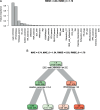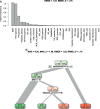Using Machine Learning-Based Algorithms to Identify and Quantify Exercise Limitations in Clinical Practice: Are We There Yet?
- PMID: 37703323
- PMCID: PMC11882194
- DOI: 10.1249/MSS.0000000000003293
Using Machine Learning-Based Algorithms to Identify and Quantify Exercise Limitations in Clinical Practice: Are We There Yet?
Abstract
Introduction: Well-trained staff is needed to interpret cardiopulmonary exercise tests (CPET). We aimed to examine the accuracy of machine learning-based algorithms to classify exercise limitations and their severity in clinical practice compared with expert consensus using patients presenting at a pulmonary clinic.
Methods: This study included 200 historical CPET data sets (48.5% female) of patients older than 40 yr referred for CPET because of unexplained dyspnea, preoperative examination, and evaluation of therapy progress. Data sets were independently rated by experts according to the severity of pulmonary-vascular, mechanical-ventilatory, cardiocirculatory, and muscular limitations using a visual analog scale. Decision trees and random forests analyses were calculated.
Results: Mean deviations between experts in the respective limitation categories ranged from 1.0 to 1.1 points (SD, 1.2) before consensus. Random forests identified parameters of particular importance for detecting specific constraints. Central parameters were nadir ventilatory efficiency for CO 2 , ventilatory efficiency slope for CO 2 (pulmonary-vascular limitations); breathing reserve, forced expiratory volume in 1 s, and forced vital capacity (mechanical-ventilatory limitations); and peak oxygen uptake, O 2 uptake/work rate slope, and % change of the latter (cardiocirculatory limitations). Thresholds differentiating between different limitation severities were reported. The accuracy of the most accurate decision tree of each category was comparable to expert ratings. Finally, a combined decision tree was created quantifying combined system limitations within one patient.
Conclusions: Machine learning-based algorithms may be a viable option to facilitate the interpretation of CPET and identify exercise limitations. Our findings may further support clinical decision making and aid the development of standardized rating instruments.
Copyright © 2023 The Author(s). Published by Wolters Kluwer Health, Inc. on behalf of the American College of Sports Medicine.
Figures




Similar articles
-
Inspiratory Constraints and Ventilatory Inefficiency Are Superior to Breathing Reserve in the Assessment of Exertional Dyspnea in COPD.COPD. 2019 Apr;16(2):174-181. doi: 10.1080/15412555.2019.1631776. Epub 2019 Jul 5. COPD. 2019. PMID: 31272243
-
[Standard technical specifications for methacholine chloride (Methacholine) bronchial challenge test (2023)].Zhonghua Jie He He Hu Xi Za Zhi. 2024 Feb 12;47(2):101-119. doi: 10.3760/cma.j.cn112147-20231019-00247. Zhonghua Jie He He Hu Xi Za Zhi. 2024. PMID: 38309959 Chinese.
-
Using Cardiopulmonary Exercise Testing to Understand Dyspnea and Exercise Intolerance in Respiratory Disease.Chest. 2022 Jun;161(6):1505-1516. doi: 10.1016/j.chest.2022.01.021. Epub 2022 Jan 19. Chest. 2022. PMID: 35065052 Review.
-
Dynamic Ventilatory Reserve During Incremental Exercise: Reference Values and Clinical Validation in Chronic Obstructive Pulmonary Disease.Ann Am Thorac Soc. 2023 Oct;20(10):1425-1434. doi: 10.1513/AnnalsATS.202304-303OC. Ann Am Thorac Soc. 2023. PMID: 37413694
-
Identifying limitations to exercise with incremental cardiopulmonary exercise testing: a scoping review.Eur Respir Rev. 2024 Sep 4;33(173):240010. doi: 10.1183/16000617.0010-2024. Print 2024 Jul. Eur Respir Rev. 2024. PMID: 39231595 Free PMC article.
Cited by
-
On the development of diagnostic support algorithms based on CPET biosignals data via machine learning and wavelets.PeerJ Comput Sci. 2025 Jan 30;11:e2474. doi: 10.7717/peerj-cs.2474. eCollection 2025. PeerJ Comput Sci. 2025. PMID: 40062300 Free PMC article.
-
Improving cardiovascular risk stratification through multivariate time-series analysis of cardiopulmonary exercise test data.iScience. 2024 Aug 22;27(9):110792. doi: 10.1016/j.isci.2024.110792. eCollection 2024 Sep 20. iScience. 2024. PMID: 39286486 Free PMC article.
-
Transitioning from stress electrocardiogram to cardiopulmonary exercise testing: a paradigm shift toward comprehensive medical evaluation of exercise function.Eur J Appl Physiol. 2025 Jul;125(7):1749-1760. doi: 10.1007/s00421-025-05740-2. Epub 2025 Mar 21. Eur J Appl Physiol. 2025. PMID: 40116893 Review.
References
-
- Balady GJ Arena R Sietsema K, et al. . Clinician’s guide to cardiopulmonary exercise testing in adults. Circulation. 2010;122(2):191–225. - PubMed
-
- Kodama S Saito K Tanaka S, et al. . Cardiorespiratory fitness as a quantitative predictor of all-cause mortality and cardiovascular events in healthy men and women: a meta-analysis. JAMA. 2009;301(19):2024–35. - PubMed
-
- Korpelainen R Lamsa J Kaikkonen KM, et al. . Exercise capacity and mortality—a follow-up study of 3033 subjects referred to clinical exercise testing. Ann Med. 2016;48(5):359–66. - PubMed
-
- Wasserman K. The Dickinson W Richards lecture. New concepts in assessing cardiovascular function. Circulation. 1988;78(4):1060–71. - PubMed
MeSH terms
LinkOut - more resources
Full Text Sources

